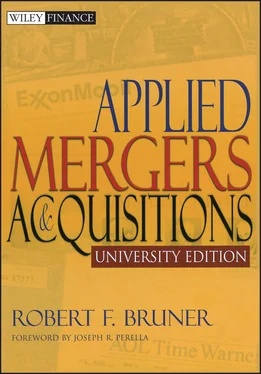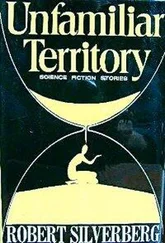CROSS-BORDER M&A ACTIVITY
The volume of cross-border M&A transactions has risen to record levels in recent years. Exhibit 5.1presents the trends of transactions involving a U.S.-based buyer or target:
Number of deals. Columns 1, 2, and 3 show that the volume of transactions by number of deals more than doubled from 1991 to 2000—and then fell to half by 2002. Classifying by whether the deal was “inbound” (i.e., where a U.S. firm was the target) or “outbound” (i.e., where a U.S. firm was the buyer) reveals that the biggest growth in the 1990s occurred in the number of outbound deals.
Dollar value of deals. Columns 4, 5, and 6 show huge increases in the dollar value of cross-border deals. In all years but two, the value of inbound deals has been greater than outbound deals (i.e., reversing the observation based on number of deals). Comparing the data on number of deals and value of deals, it appears that U.S. buyers have bought a larger number of smaller foreign targets, while foreign buyers have bought a smaller number of larger U.S. targets.
Cross-border volume relative to total M&A volume. Columns 7 and 8 present the percentage of cross-border deals relative to total amounts for U.S.-based deal volume. The cross-border number of deals represents between 17.6 and 25 percent of the total. And comparing the dollar volumes with the total inbound and outbound foreign direct investment (FDI) in the United States, M&A volume accounts for the bulk of FDI. 1
Looking beyond the confines of U.S.-related deals, the United Nations Conference on Trade and Development (UNCTAD) estimates that cross-border acquisition is the largest medium of foreign direct investment, accounting for 55 to 60 percent of the totals. 2 The volume of cross-border M&A is even larger if one considers other kinds of corporate transactions (e.g., joint ventures and project financings) possibly as partial or creeping acquisitions. 3 However, by any measure, cross-border M&A is sizable, and is a material element of all (i.e., domestic and cross-border) M&A activity.
Cross-border transactions have a different profile compared to domestic deals. Researchers have found that cross-border deals are:
More related. Cross-border acquisitions tend not to represent diversification far beyond the buyer’s core industry. Acquisitions into related businesses represent 60 to 75 percent of cross-border deals. 4
Payment is mainly in cash. Many cross-border buyers do not have shares listed for trading in the foreign market. Therefore, it is not surprising that buyers tend to pay with cash rather than stock. 5
Targets are mainly manufacturing firms with low intangible assets. Conn and Nielsen (1990) found that 97 percent of U.S. firms’ targets and 74 percent of U.K. firms’ targets were in manufacturing rather than finance or services.
EXHIBIT 5.1 Trends in Completed Cross-Border Mergers and Acquisitions Involving a U.S.-based Buyer or Target
| Column |
1 |
2 |
3 |
4 |
5 |
6 |
7 |
8 |
9 |
10 |
|
Number of Cross-Border Deals |
Value of Cross-Border Deals |
Cross-Border Deals as a Percentage of All Transactions (Domestic and Cross-Border) |
Value of All Foreign Direct Investment into and out from the United States |
|
Total Number |
Number of Inbound Deals |
Number of Outbound Deals |
Total Value (Billions) |
Value of Inbound (Billions) |
Value of Outbound (Billions) |
% of Number of Deals |
% of Total Value |
Inbound U.S. FDI (Billions) |
Outbound U.S. FDI (Billions) |
| 2002 |
1,489 |
649 |
840 |
$107.0 |
$ 65.0 |
$ 42.0 |
17.6% |
10.8% |
$ 39.6 |
$137.8 |
| 2001 |
2,063 |
888 |
1,175 |
$216.0 |
$118.4 |
$ 97.6 |
20.3% |
14.3% |
$157.9 |
$156.0 |
| 2000 |
3,259 |
1,391 |
1,868 |
$433.8 |
$311.5 |
$122.3 |
24.0% |
13.7% |
$287.7 |
$152.4 |
| 1999 |
2,701 |
1,059 |
1,642 |
$349.9 |
$229.9 |
$120.0 |
25.0% |
23.2% |
$282.5 |
$155.2 |
| 1998 |
2,630 |
884 |
1,746 |
$320.3 |
$191.8 |
$128.6 |
21.9% |
22.2% |
$193.4 |
$132.8 |
| 1997 |
2,205 |
790 |
1,415 |
$143.8 |
$ 70.7 |
$ 73.1 |
20.7% |
17.9% |
$109.3 |
$109.8 |
| 1996 |
1,952 |
689 |
1,263 |
$121.2 |
$ 65.2 |
$ 56.0 |
19.8% |
17.6% |
$ 89.0 |
$ 92.7 |
| 1995 |
1,746 |
619 |
1,127 |
$ 83.2 |
$ 42.0 |
$ 41.1 |
19.9% |
17.8% |
$ 59.6 |
$ 99.5 |
| 1994 |
1,415 |
555 |
860 |
$ 60.6 |
$ 39.0 |
$ 21.6 |
19.7% |
19.4% |
$ 47.4 |
$ 80.7 |
| 1993 |
1,140 |
428 |
712 |
$ 33.2 |
$ 16.6 |
$ 16.6 |
19.5% |
16.4% |
$ 52.6 |
$ 84.4 |
| 1992 |
1,033 |
431 |
602 |
$ 28.3 |
$ 13.4 |
$ 14.9 |
19.5% |
19.8% |
$ 21.0 |
$ 48.7 |
| 1991 |
1,152 |
592 |
560 |
$ 42.1 |
$ 27.6 |
$ 14.5 |
23.0% |
27.0% |
$ 23.7 |
$ 38.2 |
Sources of data: Thomson Financial Securities Data and Bureau of Economic Analysis, U.S. Department of Commerce.
Notes:
The foreign direct investment values in column 9 include only capital flows sourced from foreign markets. Funds sourced from the U.S. capital markets for acquisitions or investments made by foreign companies are not included. Hence, the comparison between column 5 and 9 is not perfect. Column 5 includes all sources of funding, domestic and abroad. Column 9 only includes foreign capital that “flowed in.” A similar incomparability exists for columns 6 and 10.
Despite the imperfect comparison between cross-border value and FDI, an analyst at the Bureau of Economic Analysis confirms that the majority of capital flowing into the United States for FDI in recent years has been for acquisitions. The analyst estimated the fraction to be between 60% and 80%.
M&A ACTIVITY WITHIN REGIONS AND TRADING BLOCS
Viewed from a global perspective, the most interesting laboratories for M&A today are the new trading blocs such as NAFTA and the European Monetary Union (EMU, or “Euroland”). 6 The reason for this is that free trade changes the rules of competition by reducing entry barriers, making it easier to exploit economies of scale, increasing capital market integration (which improves capital flows and lowers the cost of capital), improving the transfer of technology and intellectual capital, and reducing the idiosyncrasies of government regulation and tax policies. These changes, in turn, will affect M&A activity. Most observers expect product market competition within trading blocs to increase thanks to greater transparency about product and factor prices within the blocs. For instance, with product prices denominated in the same units across Euroland, the more efficient producers are motivated to enter new markets and compete on price. In this context, M&A is used as both a defensive and an offensive tactic. The history of M&A in the United States offers abundant evidence that M&A waves are significantly driven by product market changes. Capital markets are likely to integrate more rapidly within trading blocs, making M&A financing cheaper, easier to obtain, and available in forms that are tailored more readily to the needs of M&A participants. We know that the level of capital costs and the availability of financing significantly influence M&A activity. Sleuwagen (1998) found that over the period 1994–1996, about 60 percent of all mergers and acquisitions in the EU involved firms located in the same member state. Pointing to the experience with NAFTA, many analysts believed that with the advent of the euro, the percentage of same-country mergers would decline and cross-border deals would rise.
Читать дальше












